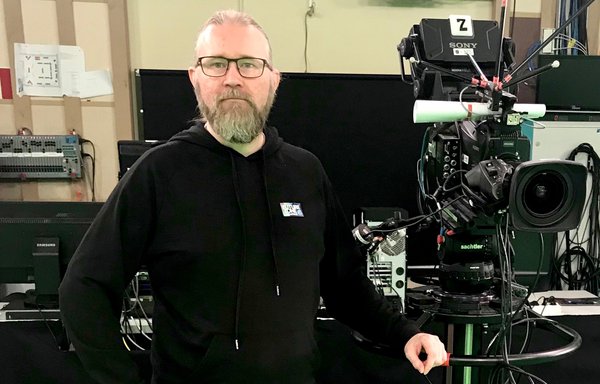Keho Interactive combines the real and the virtual
6.8.2018A new kind of virtual studio developed by Keho Interactive will be ready for production this year. The Tampere-based company challenges the industry with its interactive and scalable system.

”Let’s go to the studio and see, what this is all about.” Mikko Karsisto, the CEO of Keho Interactive, leads his visitor into the premises of Mediapolis, the centre for content production and digital industries in Tampere.
The systems are running, lights are on, the visitor can step into a green room and in front of a camera – to watch a monitor and see oneself walking in an animated garden where cherry petals are floating in the air… Karsisto moves the camera and the virtual studio reacts smoothly, maintaining the natural quality of the virtual scene.
– There are three ways to use the virtual studio, this being one of them. We can bring real elements, like people, into the virtual environment in real-time, Karsisto explains.
The second way to use virtual studio was tested successfully during the Pyeongchang Winter Olympics with the Finnish Broadcasting Company YLE. Keho Interactive added virtual elements into a live studio show, things like 3D ski track maps and hologram interviews. (For more details, please see the Keho Interactive blog.)
The third option is to use the virtual studio for pre-visualisation and support for actors in productions (movies, commercials) that rely heavily on 3D graphics.
– That is a very interesting field, and we’ve examined it with a Tampere-based company Troll Visual Effects, Karsisto says.

Sports, e-sports, children’s programmes, news and current affairs shows are likely users for the virtual studio both for live broadcasting and pre-recording. Mediapolis is the home base of Keho Interactive, but it’s by no means a prison for the technology.
– Our virtual studio works in any location that is suitably equipped. The speciality of our system is the scalability, ranging from very small projects to really large productions, Karsisto explains.
The Keho Interactive virtual studio is bound to be ready for production by autumn 2018, and the development will continue after that. The story so far is swift in its progress, starting from a small-scale motion capture system that Karsisto’s earlier game company developed to make the animations it needed.
– In the early days of the Mediapolis project, we were asked whether we had any interest in creating a mocap studio in Tampere. We did have, and that’s how Keho Interactive Ltd was first initiated, Karsisto says.
Interest in new technologies is the main driver for Mikko Karsisto and the whole Keho Interactive crew, so they soon had some new ideas: why not use the mocap system to track cameras and create a new kind of virtual studio, the one that is now near completion. The prototype has been developed together with YLE.
– Mediapolis and YLE have been very important enablers for the development of this technology and our company. We also collaborate closely with the universities of Tampere, says Karsisto.

Virtual studios are already in use around the world, for example for news and current affairs shows. Keho Interactive does have something new to offer: interactivity that is created by using a game engine.
– We make a special effort to allow easy control over the virtual environment. It can also react for example to the movements of the presenter or to messages sent by the audience, Karsisto says.
The aim is to combine real and virtual elements so seamlessly that a viewer can not tell the difference. For this Keho Interactive needs advanced technological expertise, but also deep knowledge of human perception. For example, if shadows work naturally, a viewer barely notices them – but if they work in a wrong way, a viewer has a nagging feeling that the whole scene is somehow flawed
– Developing the virtual studio is to learn constantly. We are moving on the fascinating edges of new technologies, examining and testing as we go, Karsisto says.